Pearls: Very Cultured
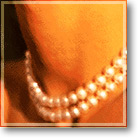 Pearls
are an organic gem, created when an oyster covers a foreign
object with beautiful layers of nacre. Long ago, pearls were
important financial assets, comparable in price to real estate,
as thousands of oysters had to be searched for only one pearl.
They were rare because they were created only by chance. Pearls
are an organic gem, created when an oyster covers a foreign
object with beautiful layers of nacre. Long ago, pearls were
important financial assets, comparable in price to real estate,
as thousands of oysters had to be searched for only one pearl.
They were rare because they were created only by chance.
Today pearls are cultured by man: shell beads are placed inside
an oyster and the oyster is returned to the water. When the
pearls are later harvested, the oyster has covered the bead with
layers of nacre. Most cultured pearls are produced in Japan. In
the warmer waters of the South Pacific, larger oysters produce
South Sea cultured pearls and Tahitian black cultured pearls,
which are larger in size. Freshwater pearls are cultured in
freshwater mussels, mostly in China.
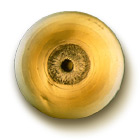
The quality of pearls is judged by the orient, which is the soft
iridescence caused by the refraction of light by the layers of
nacre, and luster, the reflectivity and shine of the surface.
Fine pearls do not have any flaws or spots in the nacre: it has
an even smooth texture. Other factors which affect value are the
regularity of the shape, size, and color: rose tints are the
most favored.
Cultured pearls and natural pearls can be distinguished from
imitation pearls by a very simple test. Take the pearl and rub
it (gently!) against the edge of a tooth. Cultured and natural
pearls will feel slightly rough, like fine sandpaper, because of
the texture of natural nacre. Imitations will feel as smooth as
glass because the surface is molded or painted on a smooth bead.
Contact us today to see beautiful cultured pearls.

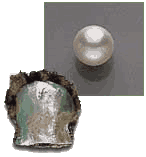
Pinctada Fucata |
Akoya
(Grown in Japan and China)
Akoya
pearls are the classic cultured pearls of
Japan. They are the most lustrous of all
pearls found anywhere in the world. In
recent years, China has been successful in
producing Akoya pearls within their own
waters. However, at this time they are
unable to produce as brilliant a lustre as
high quality Japanese Akoya cultured pearls.
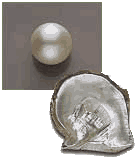
Pinctada Maxima |
White South Sea
(Grown in Australia,
Myanmar, Indonesia and the Phillipines)
White South
Sea cultured pearls are grown in large
tropical or semi-tropical oysters in
Australia, Myanmar, Indonesia and other
Pacific countries. They generally range in
size from 10mm to 20mm and command premium
prices because of their relative rarity and
large size.
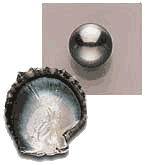
Pinctada
Margaritifera |
Tahitian
(Grown in French Polynesia)
Tahitian
cultured pearls are grown in a variety of
large pearl oysters found primarily in
French Polynesia. Their beautiful, unique
colors (which can range from light grey to
black, and green to purple) and large size
can command very high prices.
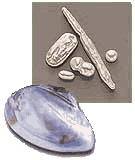
Hyriopsis
Schlegeli |
Freshwater
(Grown in Japan, China, and
The United States)
Freshwater
pearls can be found in bays and rivers
throughout the world. They are easily
cultivated from freshwater mollusks in
China, Japan and the United States. Many are
less lustrous than salt water cultured
pearls but their low price, unique shapes
and colors have made them popular jewelry
items in recent years.
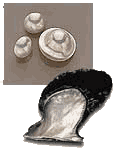
Pteria Penguina |
Mabe
(Grown in Japan, Indonesia,
French Polynesia and Australia)
Mabe
pearls are hemispherical cultured pearls
grown against the inside shell of an oyster
rather than within the oyster’s body. They
generally are used in earrings or rings
which conceal their flat backs. |
|
|

|
When
selecting a strand of cultured pearls, it’s
best to buy them from a knowledgeable
jeweler. We can explain how
to make the most of your purchase and insure
that you are getting the best quality pearls
within your price range.
You can evaluate any piece of cultured pearl
jewelry on the following quality factors.
But always remember that the better the
quality of pearls you select, the more
beautiful and valued they will be over time.

-
LUSTRE:
Lustre is a combination of surface
brilliance and a deep seated glow. The
lustre of a good quality pearl should be
bright and not dull. You should be able
to see your own reflection clearly on
the surface of a pearl. Any pearl that
appears too white, dull or chalky
indicates low quality.

-
SURFACE:
Cleanliness refers to the absence of
disfiguring spots, bumps or cracks on
the surface of a pearl. The cleaner the
surface of the pearl, the more valuable.

-
SHAPE:
Since cultured pearls are grown by
oysters in nature, it is very rare to
find a perfectly round pearl. However,
the rounder the pearl, the more valuable
it is. Baroque pearls, which are
asymmetrical in shape, can be lustrous
and appealing, and often cost less than
round pearls.

-
COLOR:
Cultured pearls come in a variety of
colors from rosť to black. While the
color of a pearl is really a matter of
the wearer’s preference, usually rosť or
silver/white pearls tend to look best on
fair skins while cream and gold toned
pearls are flattering to darker
complexions.

-
SIZE:
Cultured pearls are measured by their
diameter in millimeters. They can be
smaller than one millimeter in the case
of tiny seed pearls, or as large as
twenty millimeters for a big South Sea
pearl. The larger the pearl, other
factors being equal, the more valuable
it will be. The average sized pearl sold
today is between 7 and 7-1/2
millimeters.
|
|
|

Throughout
history, pearls have been the gift of love.
That’s why tradition has made them the bridal
jewel. No other jewel conveys the warmth, depth
of feeling and eternal qualities of that
emotion.
Giving
the gift of love is easy with cultured pearls.
As cultured pearls come in a wide variety of
styles and jewelry choices, there’s a perfect
pearl gift for everyone.
Suggested
Occasions
Sweet Sixteen • Birthdays • Valentine's Day
Mother’s Day • June Pearl Birthstone Month
Weddings • Anniversaries
Christmas • Graduation
Business Promotions
Pearl
Gifts
Necklaces • Multi-strand
Bracelets
Mabe Pearl Pendants
"Add-A-Pearl" Necklaces
Pearl Cluster Ring • Single Pearl Rings
Stud Earrings
Mabe Pearl Earrings • Tassel Earrings
Cluster Earrings • South Sea Pearl Drop
Earrings
Brooches • Cufflinks • Tie tacks |
|
|

|